Bernard came out of purdah…
… at Ghanerao Palace, near Narlai, in the countryside south of Khumbalgarh Fort.

Why fling open the carved stone lattice screens to taste the winds of freedom on his face? I suspect his gesture was born on the breezy sandal-clad feet of the confidence he’s gained drinking cup after minuscule cup of Masala chai. This is something new for Bernard, who for reasons he’s kept to himself has never deigned to take more than one, wrinkly-nosed sip of my favorite beverage.
I’d like to take credit, and say he’s followed my lead, impressed that I’ve never gotten sick regardless whether I’m sipping a tiny plastic cup at a street stand, or slurping from a saucer offered by a hospitable couple in the countryside, the milk no doubt taken from the steel canister in the shade, holding the morning’s deposit from the family Tharparkar (the gentle humped Sindh cattle breed seen all over Rajasthan).
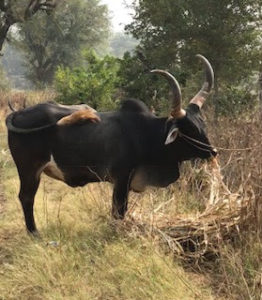
But I think the truth has more to do with his despair at the awful coffee on offer.
There has been another delightful surprise this trip, to do with animals in pet form and my contact with them. Normally in India it’s all about sacred cows and pariah dogs, and the general need to give them all as wide a berth as traffic and garbage heaps allow. This trip I had personal time with a large range of pets, and it was a real boon to my spirits. Yes, I photographed many of these sweet animals, if only to show that travel in India isn’t always about gorgeous ethnic dress, fabulous ancient forts, exquisite gold nose rings and winsome children. In truth, as I travel, the more puzzling the questions encountered each day, the more ordinary the scene at day’s end needs to be. And the more vibrant the interaction, the more I long for whatever simple thing will speak to me of home.
It all started in the Kutch where we were welcomed by the joyful prancing of Astro, young German shepherd rescued
by a staff member who found him starving on the road.
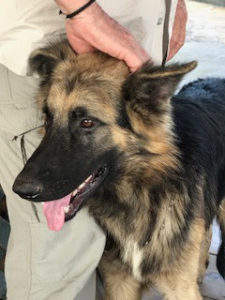

Astro had two yellow Labs for company, Max and Maya, the latter disappearing for hours to nurse her littler of month-old puppies, who were just as warm and squishy soft as they look!
In Dasada, Gujarat, our lodge had 4 Persian cats just like Blofeld’s in the 007 films, as well as 5 dogs. The cat who snuck into our room was a mother seeking some ‘me’ time—or maybe that should be ‘meow’ time— from the three kittens she’d birthed in a brass urn three days prior.

I also got to snuggle with an uncharacteristically quiet beagle and a strangely lethargic Saluki. Dasada had an impressive stable operation, which included some Kathiawari horses, one of which I got to ride. Unlike the Marwari, the Kathiawari are small, averaging 14.2, with a pretty rather than noble head. Riding one is actually a bigger deal than you might imagine, because the breed is slowly dying out, not having attracted as much attention as the Marwari which I mentioned in the previous newsletter.
It was quite a stunner to see the care (and special feed) lavished on the horses. In some ways, with so many people in India having so little, it was off-putting. But I don’t pass eery day of my travels in passing judgment, so I’ve stored away my observation of the huge buckets of grain prepared for every horse, mixed with lashings of molasses, corn oil and minerals, for later digestion. And decided in that particular moment it was just a pleasure to see animals well-cared for.
And of course there was our memorable stay at Jodha stud farm, surrounded by mares, stallions and their output— foals, ….
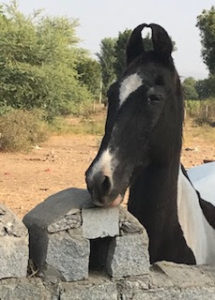
as well as sweet Tyce the Doberman and his lady Rottweiler pal.
Marwari typically make their living being in wedding processions, and though it’s not required, people do like to have white ones for that. Wedding processions are loud. And I mean LOUD!!!! as in “What did you say????” loud, with banging drums and chanting projected across kilometres (or so it seemed at night in our hotel). One day in Udaipur we came upon one and joined the crowd of family and friends accompanying the groom on his white steed. Of course I immediately felt sorry for the horse, wondering if he’d been given early retirement due to hearing loss, until I noticed his ear protection. Take a close look and you’ll see:

So things on the domestic animal front were pretty swell. They weren’t so bad on the work animal front either. Our camel cart bull knew how to nap with the best of them, but instead of folding his legs under himself neatly, he sprawled full out on the sand in a good imitation of “Dead to the world,” as soon as he was unharnessed.
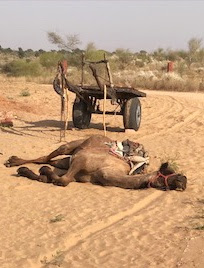
There was a new sight for me from mid-Rajasthan onward; the feral pigs rampaging around certain towns. Even those Hindus who eat meat now and then eschew pork, so why are there pigs running around? Turns out it’s someone’s bright idea of a way to get rid of more of the street garbage. Thing is, the pigs aren’t neutered, just as street dogs and bulls aren’t neutered. So the pigs are breeding like that other barnyard animals, rabbits, turning aggressive and sporting bristles on their back that put Bernard’s shaving brush to shame. We’d see people chasing them out of the yard with a broom, keeping a good distance in case one dissented. Monster sows with full teats were trailed by piglets, in turn shepherded by the adolescent, already-weaned, generation. And I don’t want to go into the sight of a feral boar rooting around in the heaps of soiled rags and plastic.
And then there are the black rats. I’m talking about the 25,000 that call Karni Mata Temple in Deshnoke, home. These are holy rats —kabbas, and many people travel great distances to pay their respects, as did we.
First rule before entering any temple–even one not especially pristine—is remove the shoes, which I did, refusing the reusable muslin foot coverings other–I’ll call them the squeamish– were taking. I felt brave about that. Then I approached the rat gift cart, as i didn’t want to enter a place swarming with rodents without something to distract them, should I need to. The vendor handed me a plastic tub of wrinkled yellow pebbles. Dried chick peas to me, apparently a welcome treat to a rat. “Favorite, favorite” he assured me, in that Indian way where doubling or tripling a word adds strength to the sentiment. As though I might ruin my karma forever if a rat didn’t like my offering.
I put aside my gag reflex as I padded barefoot across a white marble floor tacky with rat pee, centuries of it. I notice one thing immediately: the rats are not black. They’re a uniform ratty brown, with rather ratty coats, regardless that they have a 24 hour buffet at their disposal.
Once the temple entrance is breached I approach the sanctuary the goddess with my little plastic tub and great feelings of general piety. So I am mildly fussed to be turned abruptly away. The silver doors open for the faithful only. And those faithful are arriving with brass bowls heaped with orange marigolds, some with a golden box of premium Indian whisky or rum under each arm. What I secretly think is, “Who’s drinking all that liquor?” Followed by, “This goddess is my kinda gal!”

I shuffle off around the shrine, past large basins of milk with rats delicately sipping as they cling to the rim. One or two can’t be bothered with such politesse, choosing to wade right into their drink. A furry creature scuttles toward a hill of millet, brushing against my foot before rebounding away in a new direction. I mutter about “sacred who cares” as my sticky soles squelch rat droppings. Around the corner a handful of satiated rats frolic and tumble, dancing on hind legs and somersaulting. When I see a rat stagger across the marble courtyard, likely in the last throes of some contagious ratty démentia, I decide it’s time to leave.
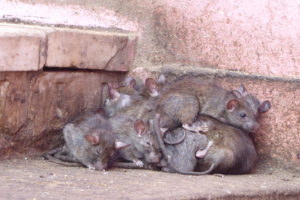
There were even some bird interludes on this trip, like the miracle of seeing hundreds of migrating Demoiselle cranes at Kheechan, where for 150 years villagers have been offering them bribes in the form of plentiful grain and a little lake, so that they return every winter. The ones we saw likely flew in from Mongolia or China, and they were gorgeously regal birds to watch, which we did in the company of a number of Kheechan villagers who daily come to check on ‘their’ birds.
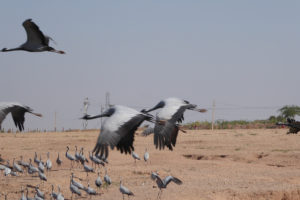
You can probably tell that my interaction with animals on this India trip has lifted my spirits immensely. That is until the afternoon I was wandering an old city neighborhood and from somewhere on high a pigeon pooped on my head. It really did. And there’s nothing more to say about that.










